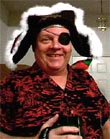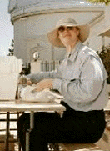|
|
This topic comprises 5 pages: 1 2 3 4 5
|
|
Author
|
Topic: Location of soundtrack on film
|
|
|
|
|
Stephen Furley
Film God

Posts: 3059
From: Coulsdon, Croydon, England
Registered: May 2002
|
 posted 10-13-2003 02:11 AM
posted 10-13-2003 02:11 AM




The other formats are:
Standard 8 magnetic 56 frames in advance
Super 8 magnetic 18 frames in advance
9.5mm optical 26 frames in advance
16mm optical 26 frames in advance
16mm magnetic 28 frames in advance
35mm magnetic 28 frames in retard
35mm Dolby Digital 26 frames in advance
35mm CDS in level sync
35mm SDDS is different on each edge, I can't remember the details, but there was a post about it a few months ago.
9.5 mm magnetic seems to vary, there were separate sound bases available some of which had a long path from the gate to the sound head. Also, some machines used a stripe on the left edge, and some on the right!
17.5 mm (the Pathe Rural version, all the other versions were far too early to have had a sound track) is an odd one, there were two standards, 20 and 26 frames in advance, one was used in Europe and the other in America, though the format was never very popular there. I can't remember which was used where.
Can anyone give me the figures for:
70mm Fox Grandeur optical.
The proposed 55.625mm six perf Cinemascope 55 release format.
Super 8 optical.
Standard 8 optical (I have seen a short sample, but I don't think the format was ever adopted).
Any others.
| IP: Logged
|
|
|
|
|
|
|
|
|
|
|
|
|
|
|
|
|
|
Stephen Furley
Film God

Posts: 3059
From: Coulsdon, Croydon, England
Registered: May 2002
|
 posted 10-14-2003 07:58 AM
posted 10-14-2003 07:58 AM




Phil, thank you for the info on 70mm. 23*5/4=28.75 so just slightly longer than the path for 35mm.
Brad, not a typo, I'm pretty sure the 56 frame figure is correct, but if not, then it's a brain malfunction, not a fingers one.
I used the term 'Standard 8' which is almost universally used here, but I don't think it was ever officially used by Kodak. Phil used the term 'Regular 8', which is less common here. I don't know if this term was ever used by Kodak, they tended to just call it '8mm', which became rather confusing after the introduction of Super 8 in 1965.
To return to the sound advance question, it is much greater on Standard 8, than on Super 8. I think the 56 frame figure is correct, but I'll come back to that in a minute. This distance would, in some ways, make sense. Firstly, it would be the same distance as the 28 frame magnetic advance on 16mm, which would simplify the design of 16mm/Standard 8 dual gauge projectors. I don't know if any sound ones were actually built, but there were several silent ones, so it's possible. Secondly, the greater distance made it easier to design a separate sound base to be used with an existing silent projector. These certainly did exist, though they were more common for 9.5mm. Most silent projectors did not run at a constant speed, you adjusted the knob until it sounded right, and kept adjusting it as the machine warmed up!
Later, dual format Standard 8 / Super 8 sound projectors were introduced, and on these the difference in sound advance was a problem. I have one from the late '60s, which threads automatically through the gate, but manually from that point on. There are dotted lines cast into the metal casing of the projecter, showing the correct size lower loops for the two formats, and the Standard 8 one is very large. On later machines, which had fully automatic threading there was a horribly complex plastic guide system which formed the correct sized loop, depending on which gate was installed.
I few companies built 8mm projectors with reasonable sound systems in them, e.g. Elmo, but most were terrible, there was no proper sound drum, and certainly nothing like a 35/70 magnetic reader, just a system which would have been more at home in a tape recorder. Standard 8 sound was not common, I have a few shorts in my collection, it was purely a home movie system, and the equipment was very expensive for home use, few people bought it. The stripe was outside the perforations, exactly like the balance stripe on 16mm, and the combination of the rather large perforations alongside the track, the primative sound head design and the large loop of film flapping about made the system rather unstable. Super 8 was designed from the start to have magnetic sound, and in later years there were machines which could play a second track from the balance stripe. It is still possible to buy Super 8 prints with 4 channel (matrixed) tracks, and the sound is pretty good, I don't have any, the cost is not a great deal less than for a 35mm print! I think about 600 to 800 pounds for a full length feature.
Super 8 did have some non-home use as an exhibition format, the airlines used it, with optical sound, for a while before switching to video. It was also used to a limited extent in education, and was under serious consideration for television news work, but the idea was dropped when portable video equipment became available.
I have a couple of 8mm sound machines in my store, unused for several years. I have to go there in the next few days to get out a pair of Bell and Howell 666s which somebody is borrowing for a show, I'll check the sound advance on Standard 8 while I'm there.
Anyway, enough of this bootlace stuff, I'm heading up to york next month to hear (and see) the 70mm; anyone else going to be there?
| IP: Logged
|
|
|
|
|
|
Frank Angel
Film God

Posts: 5305
From: Brooklyn NY USA
Registered: Dec 1999
|
 posted 10-14-2003 12:19 PM
posted 10-14-2003 12:19 PM





There was a very sophistocated system years ago, circa 1960s from a company called Inner Space, that married a tape deck to the camera and projector. You sent them your S8mm camera and they modified it so that it could output a pulse for every frame advance. You used a portable tape deck, typically a Uher or Nagra which recorded the pulses on one channel and audio on the other. For playback, a reader on the projector shaft was fed to a controller which varied the speed of the tape deck by generating a drive voltage based on the projector shaft speed compared to the pulse count from the control track on the tape deck. It worked quite well, the only drawback being it your projector had really unstable speed problems, you could hear the speed varying in the sound. But any decent projector that kept reasonable steady speed worked fine.
You didn't even have to worry about starting the projector and the deck together because the system also included a circuit that saw a cue on the film and started the tape deck at the same time.
The big advantage over sound on film is obvious. You had the excellent fidelity of very good r-t-r tape transport without any of the limitations of the slow speed of the film and its miniscule mag stripe.
I also recall a system from Revere which supplied you with a tape that had lines printed on the base side and a small mirror that you positioned over the aperture to deflect the intermittent light from the projector onto the tape traveling through the tape deck. The strobe effect would make the lines look like they were standing still when the projector was at 18fps. You would have to continually control the projector speed manually, but it did work if you didn't need lipsync.
Then there were the add-on devices, one in particular that I recall that you put in place of the supply reel. It basically was a record/playback head that film which was mag striped ran through. From what I remember a salesman saying at the time, the sound was attrocious, and of course, it could only be used for adding music or sound effects -- no location sound.
Frank
| IP: Logged
|
|
|
|
All times are Central (GMT -6:00)
|
This topic comprises 5 pages: 1 2 3 4 5
|
Powered by Infopop Corporation
UBB.classicTM
6.3.1.2
The Film-Tech Forums are designed for various members related to the cinema industry to express their opinions, viewpoints and testimonials on various products, services and events based upon speculation, personal knowledge and factual information through use, therefore all views represented here allow no liability upon the publishers of this web site and the owners of said views assume no liability for any ill will resulting from these postings. The posts made here are for educational as well as entertainment purposes and as such anyone viewing this portion of the website must accept these views as statements of the author of that opinion
and agrees to release the authors from any and all liability.
|

 Home
Home
 Products
Products
 Store
Store
 Forum
Forum
 Warehouse
Warehouse
 Contact Us
Contact Us




 Printer-friendly view of this topic
Printer-friendly view of this topic












![[Wink]](wink.gif) It's been way too long, but I think it's 18 frames in advance.
It's been way too long, but I think it's 18 frames in advance.






